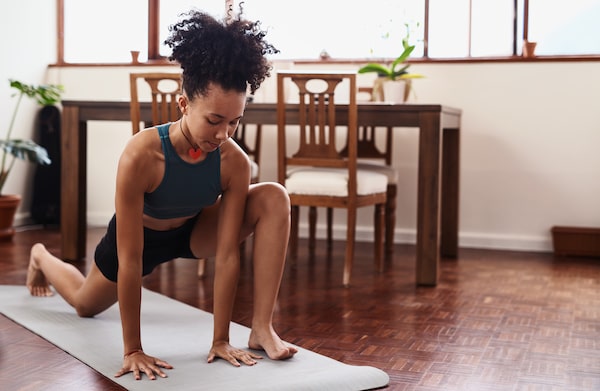
Shot of a young woman practicing yoga at home Your body deserves the gift of good health Lunge stretch dynamic yogaHiraman/Getty Images
I was 14 kilometres into my first half marathon when the slight discomfort I’d been ignoring in my right shin suddenly morphed into a shooting pain. I half-jogged, half-limped my way to the finish line, where my running buddy threw me onto his back and carried me to the subway. I had just suffered a stress fracture, a tiny crack in the bone caused by repetitive force and overuse.
Though I had noticed the ache weeks earlier, I kept training because the drive to reach my New Year’s goal of completing the 21K race was stronger than both my logic and my pain receptors. But in neglecting to listen to my body’s pleas for rest, I ended up injured, dropping out of my upcoming marathon and stumbling around the city in an air cast for six weeks. The whole ordeal could have been avoided by making one simple change to my training: taking scheduled rest days.
“Whether you’re a pro athlete or a recreational fitness enthusiast, rest days are always crucial,” says Marco Capizzano, founder of Toronto’s stretch therapy clinics, b-stretched. “They’re an underestimated component of any effective fitness routine.
If you resolved to hit a fitness goal this year, taking a day off might feel like a step backward. But it’s within those periods of rest, not during the sweat session itself, that you become stronger, more powerful, and more motivated to keep going.
This is your body on rest
Most forms of exercise, and particularly strenuous ones like strength training and running, create microtears in our muscles. During periods of rest (including sleep) our muscles repair themselves, adapt, and become stronger as they heal. “That’s how strength develops,” explains Amy West, a physician and CrossFit coach. Keep pushing that stressed tissue and you risk increased inflammation and the potential for injury.
“Due to repetitive stress on joints and muscles, we see a lot of people with inflammatory injuries in January,” says Capizzano. “You may not feel the microscopic damage instantly, but it increases when compounded day after day.”
Consistently hitting back-to-back high intensity workouts without breaks can lead to overtraining syndrome (OTS), which affects up to 30 per cent of athletes on sports teams and 50 per cent of regular gym-goers and individual-sport athletes, according to the Canadian Academy of Sports Nutrition. Symptoms of OTS can include injury, illness, fatigue, diminished output capability in future workouts, and even mood changes.
And while you may have been able to hit consecutive high-intensity workouts day after day in your 20s and early 30s, as we age, rest days become even more important because “we begin to lose elasticity in our muscles,” says Capizzano.
Improve your performance
During intense exercise, your body relies on glycogen (the body’s stored form of carbohydrates) stored within your muscles. When those levels get too low, you might start to feel sluggish or fatigued. To replenish glycogen, your body needs a combination of rest and carbohydrates before you begin another workout. Returning to exercise without adequate rest can lead to decreased performance as well as a greater risk of injury, according to the Journal of Athletic Training.
Then there’s the dreaded workout plateau or regression, when the gains you’ve been making during your sessions grind to a halt and it feels like you’ve got nothing left to give. It might feel counterintuitive but hitting the brakes can ultimately lead to better output in your next workout.
When you skip rest days, “you’re working under extreme fatigue, which can make you more prone to not being able to work out as efficiently or as hard,” says West. You may find yourself compromising form and intensity to compensate for achy muscles.
When to rest and what to do
“The general rule is 24 hours of rest after a mild to moderate workout, 48 after a moderate to severe intensity workout, and maybe 72 if you’ve done something very, very strenuous, like run a big race,” says West.
Can’t sit still during a rest day? You don’t have to. Active rest – dynamic stretching, walking, low-intensity swimming, gentle yoga – help boost circulation and blood flow to aid muscle recovery and are unlikely to compound muscle fatigue.
Capizzano suggests starting with two of his favourite dynamic stretches:
Standing active hip flexor marches: Stand in place, keep your core engaged, and bend and lift one knee to hip height without bending the knee of your supporting leg. Repeat on the other side.
Dynamic lunge rotations: Start in a full lunge with your right leg forward. Place both hands on the ground near the inside edge of your front foot. Lift your right hand and rotate your torso toward your front leg raising your right arm overhead, and try to stack one shoulder on top of the other. Return to your starting position slowly and with control. Step your left foot forward to meet the right, rise to standing, and repeat the movement on the left side.
While taking breaks from your workout might feel like a step back from reaching your goals, remember that wherever your finish line is, it will feel much better to burst through it triumphantly than to hobble across.
If soreness or achiness turns into pain or persists, it’s important to speak with your doctor about a potential injury or chronic condition.
Alyssa Ages is a journalist and the author of Secrets of Giants: A Journey to Uncover the True Meaning of Strength, published by Avery/Penguin Random House in September, 2023. She is also a strongman competitor and endurance athlete, as well as a former personal trainer and group fitness instructor.